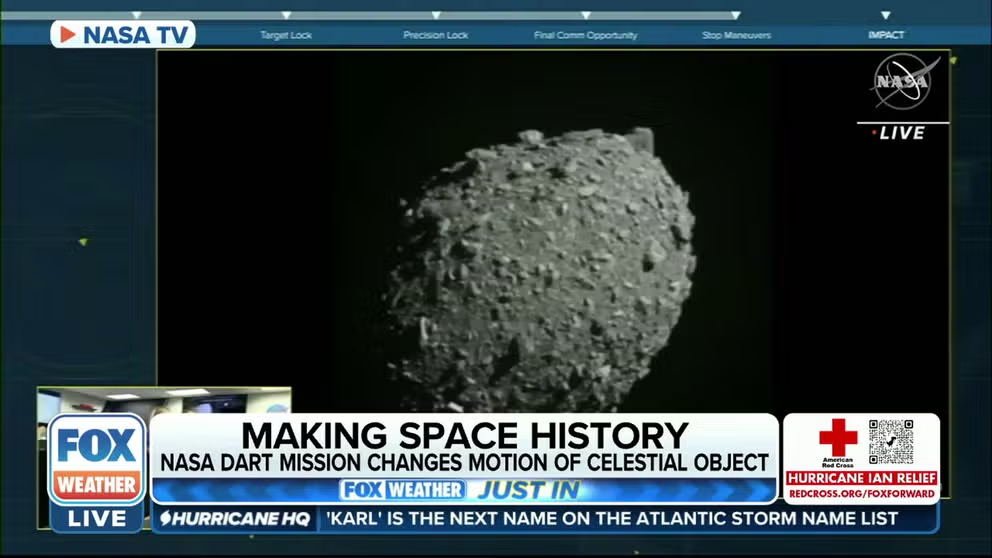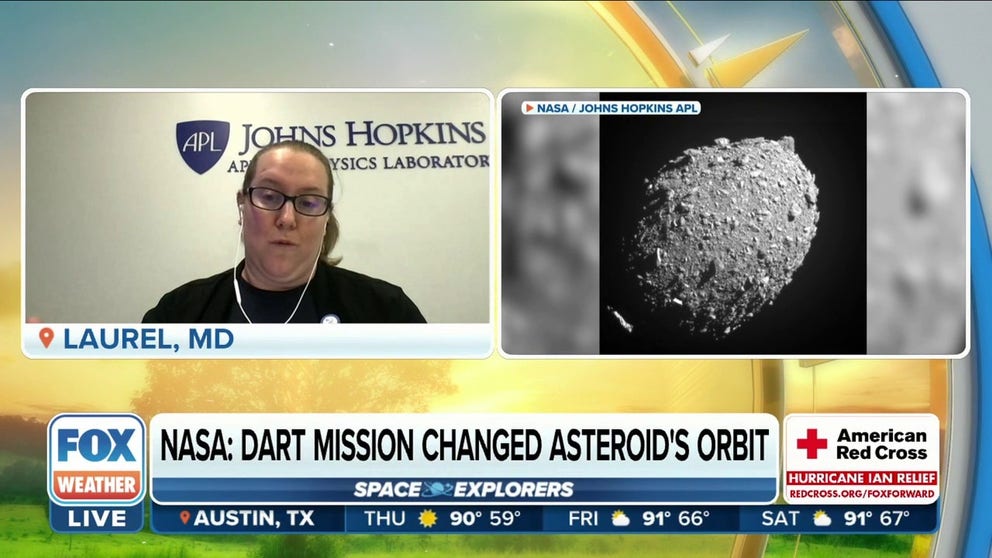Smashing success: NASA’s first planetary defense test changes asteroid’s orbit by 32 minutes
The moonlet asteroid previously took almost 12 hours to orbit the larger Didymos. Now, based on ground-based telescope observations, Dimorphos orbits the asteroid in 11 hours and 32 minutes.
NASA's DART mission changes motion of asteroid's orbit
NASA says its first planetary defense test changed an asteroid’s orbit by 32 minutes.
NASA leaders said Tuesday that Earthlings now have a way to fight back if an asteroid is headed here after successfully changing the orbit of an asteroid by slamming an appliance-sized spacecraft into it.
NASA’s Double Asteroid Redirect Test (DART) spacecraft launched from California last fall and zoomed through space to reach a binary asteroid system – the larger Didymos and its smaller moonlet Dimorphos, about 7 million miles from Earth.
On Sept. 26, DART used autonomous navigation to hone in on Dimorphos. Then, it charged at the space rock head first at about 15,000 mph, acting as a battering ram when it crashed into it.
Two weeks after the impact, teams with the Johns Hopkins University Applied Physics Laboratory (JHUAPL) and NASA provided an update on what they’ve learned from DART’s smash.
The goal was to test one option to protect Earth from asteroids known as the kinetic impactor theory. A successful mission would change Dimorphos’ orbit around Didymos but only by a few percent.
On Tuesday, NASA Administrator Bill Nelson confirmed the first planetary defense test was a "bull's-eye," saying DART's impact changed the orbit of Dimorphos around Didymos by 32 minutes.
The moonlet asteroid previously took nearly 12 hours to orbit the larger Didymos. Now, based on ground-based telescope observations, Dimorphos orbits the asteroid in 11 hours and 23 minutes, a change of about 4%.
"All of us have a responsibility to protect our home planet. After all, it's the only one we have," Nelson said. "This mission shows that NASA is trying to be ready for whatever the universe throws at us. I believe that NASA has proven that we are serious as a defender of the planet."
The spacecraft brought along a companion in the form of a tiny spacecraft built by the Italian Space Agency (Agenzia Spaziale Italiana) called LICIACube.
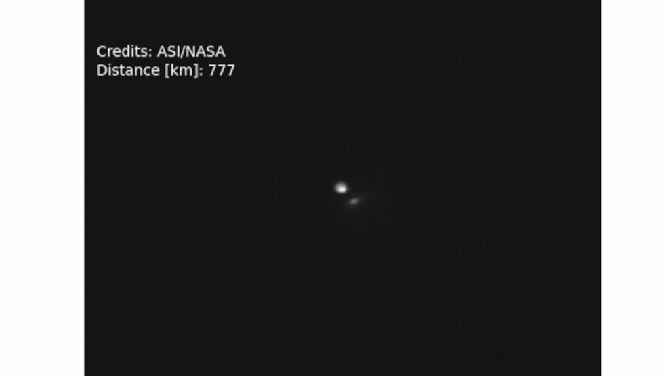
Images from the LUKE camera on ASI’s LICIACube, captured just after the impact of NASA’s DART spacecraft with the asteroid Dimorphos on Sept. 26, 2022. The video begins with LICIACube around 500 miles away from the asteroid, passes by, and then continues to around 200 miles away. The video clearly shows the ejection of material streaming off of Dimorphos due to the impact. (Credits: ASI/NASA)
Three minutes after DART made a direct hit, LICIACube flew by the asteroid using two cameras, LUKE and LEIA, to survey the damage.
Images from the LUKE camera shared by the ASI on Tuesday were taken from around 500 miles to 200 miles away. They showed the ejection of material streaming off of Dimorphos after DART's impact.
NASA's asteroid redirection test successfully alters path
Angela Stickle, Planetary Geologist at the Johns Hopkins Applied Physics Laboratory, talks about NASA’s first planetary defense test that changed an asteroid’s orbit by 32 minutes.
DART coordination lead Nancy Chabot, with APL, said the kinetic impactor technique has the potential to deflect an asteroid in the future but with more lead time.
"If you wanted to do this in the future, potentially it could potentially work, but you'd want to do it years in advance," Chabot said. "Warning time is really key here in order to enable this sort of asteroid deflection to potentially be used in the future as part of a much larger planetary defense strategy."
Checking DART's homework
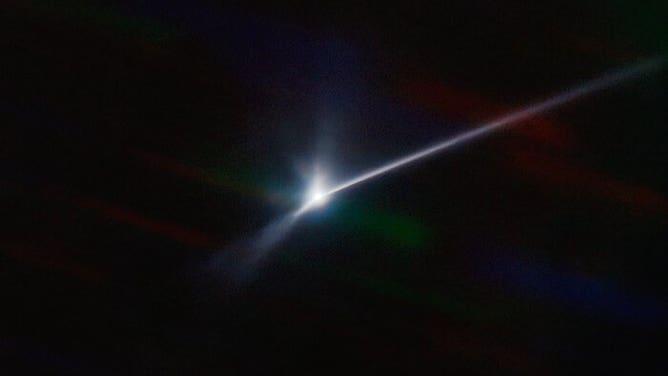
Astronomers using the NSF’s NOIRLab’s SOAR telescope in Chile captured the vast plume of dust and debris blasted from the surface of the asteroid Dimorphos by NASA’s DART spacecraft when it impacted on 26 September 2022. (Image Credit: CTIO/NOIRLab/SOAR/NSF/AURA/T. Kareta (Lowell Observatory), M. Knight (US Naval Academy)
NASA used several methods to determine DART’s success and the data was verified by two independent research groups.
'LOSS OF SIGNAL:' NASA SUCCESSFULLY CRASHES DART SPACECRAFT INTO ASTEROID FOR PLANETARY DEFENSE
Around the world, scientists using ground-based telescopes have been monitoring the binary asteroid system's orbit. Four telescopes in Chile and South Africa were used to provide these observations.
By using optical telescopes on Earth to monitor the asteroidal system, astronomers observed changes in light, or eclipses, when Dimorphos passed in front of Didymos.
"You can also see that these eclipse timings are very much related to the orbital period of Didymos around Dimorphos," Chabot explained. "By measuring when these eclipses happen, you can determine what that orbital period is."
Two days after DART's impact, astronomers used a National Science Foundation facility telescope in Chile to observe the massive dust and debris trail coming from Dimorphos. The debris from the moonlet asteroid has created a comet-like tail on Dimorphos that is more than 6,000 miles long.
The second data set came from planetary radar from the Goldstone Observatory in California and the Greenbank Observatory in West Virginia to track the signals of Didymos and Dimorphos.
"We are directly imaging both of these asteroids and getting their positions relative to each other," Chabot said. "And the position of Dimorphos is consistent with 11 hours and 23 minutes for its orbital period. And it is not consistent with being what the orbital period was prior to the DART impact."
Multiple spacecraft were also watching the crash when it happened, including the James Webb Space Telescope, Hubble Space Telescope and NASA's Lucy spacecraft.
On Tuesday, NASA Planetary Science Director Lori Glaze shared a new image taken this weekend of the new tail on Dimorphos.
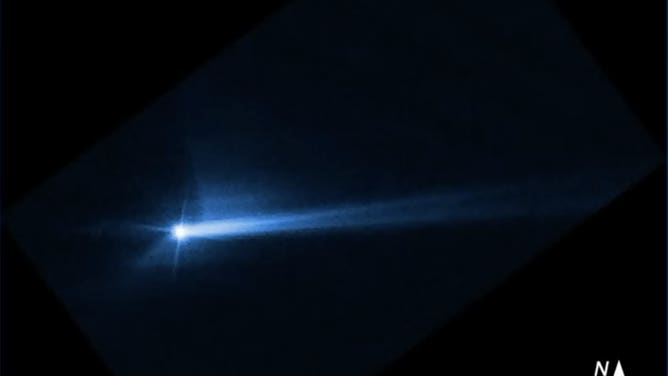
A Hubble Space Telescope image taken on Oct. 8, 2022 shows a new debris trail from Didymos and Dimorphos, the asteroid NASA rammed a spacecraft into. (Image: NASA)
ITALIAN SATELLITE WILL WITNESS DART'S ASTEROID SMASH IN THE NAME OF PLANETARY DEFENSE
"What we're seeing there is the fine-grained particles that were ejected from the asteroid being driven away from the asteroid by solar radiation pressure, very much akin to a comet," Glaze said.
Over the next few months, mission scientists will continue to observe the orbital change made by DART's hit and to fully understand the evaluation of the comet-like debris trail.
The final mission check-up will be in the form of HERA, a European Space Agency spacecraft launching in 2024. HERA will visit Didymos and Dimorphos and see the impact area up close.
Planetary defense continues
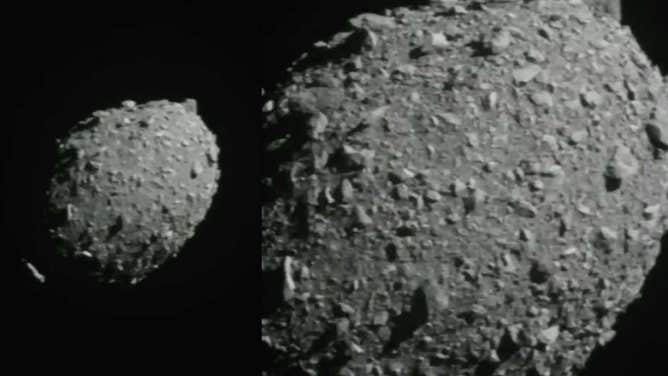
Asteroid Dimorphos as seen by NASA's DART spacecraft seconds before impact. (Image: NASA/JHUAPL)
Near-Earth asteroids or NEOs are found and classified through telescope observations from Earth and spacecraft.
Based on what scientists know about the overall population of asteroids they believe they have found about 99% of asteroids a kilometer or larger, which could cause planetary devastation. However, scientists have identified only about 40% of asteroids 140 meters or larger that could cause regional devastation to Earth.
Chabot said Dimorphos is among the asteroid group of 140-meters or larger which is a priority to learn more about.
"It's the first time we've been to an object that size and seen how it reacts," Chabot said.
Glaze said continuing to identify potentially hazardous asteroids is essential to defending our planet.
"Planetary defense is not just a problem for the United States," Glaze said. "But this is a planet-wide issue that if there were an asteroid that was a threat to Earth, we should all be concerned, and we all need to be working together to identify the asteroids, which we do with our ground-based programs."
